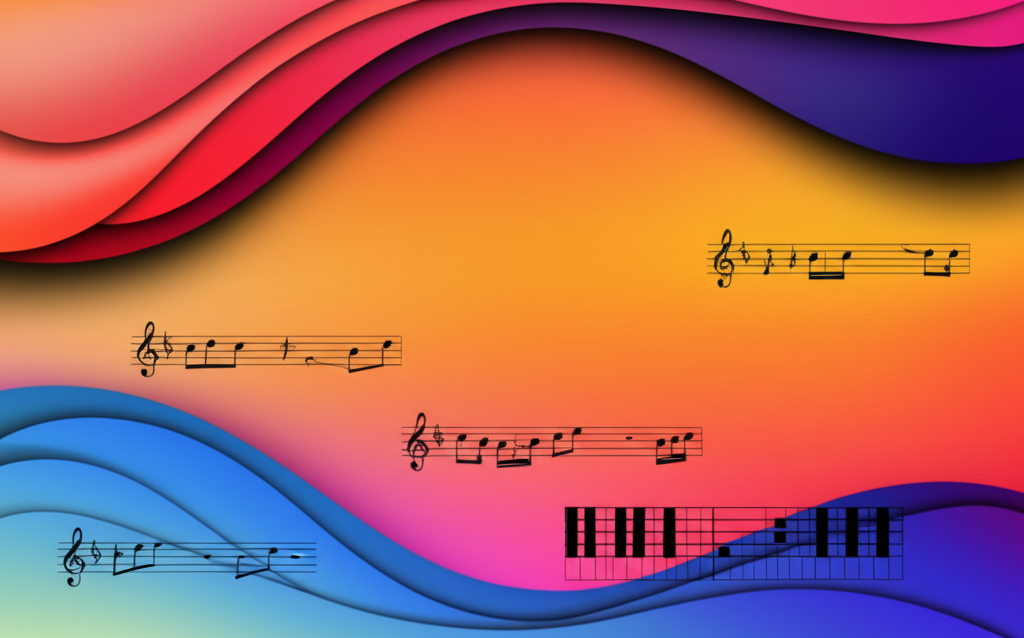
The Harmonic Minor Scale: Mystery and Tension in Music

b4n1
May 17, 2025, 4:26 p.m.
The Harmonic Minor Scale: Mystery and Tension in Music
Summary:
The harmonic minor scale is a fascinating variation of the natural minor scale characterized by its raised seventh degree. This unique alteration creates the distinctive augmented second interval that gives the scale its exotic, mysterious sound. Widely used in classical, flamenco, metal, and film music, the harmonic minor scale adds dramatic tension and emotional depth to compositions. This comprehensive guide explores the scale's structure, historical development, practical applications across musical genres, and provides musicians with exercises to incorporate this evocative scale into their melodic and harmonic vocabulary.
Keywords:
harmonic minor scale, augmented second interval, raised seventh, minor keys, classical harmony, flamenco music, metal music, film scoring, exotic scales, Eastern European music
Introduction:
Among the rich palette of musical scales, the harmonic minor scale stands out for its distinctive character—mysterious, tense, and emotionally charged. While the natural minor scale conveys melancholy and introspection, the harmonic minor scale adds an element of dramatic tension through a single yet powerful alteration: raising the seventh scale degree.
This seemingly simple modification transforms the scale's sonic character, introducing an exotic augmented second interval that evokes images of moonlit landscapes, ancient mysteries, and dramatic confrontations. It's no wonder that composers across centuries and genres have turned to the harmonic minor scale when seeking to convey intensity, urgency, or otherworldly atmospheres.
The harmonic minor scale emerged as a practical solution to a theoretical problem in tonal music: how to maintain the melancholic character of minor keys while creating a stronger resolution to the tonic. By raising the seventh degree, composers created a leading tone with a stronger pull toward the tonic, enhancing cadential resolution while preserving the minor quality of the scale.
From Bach's intricate counterpoint to Paco de Lucía's flamenco masterpieces, from Rimsky-Korsakov's exotic orchestrations to modern metal's virtuosic solos, the harmonic minor scale has proven to be an indispensable tool in the musical vocabulary. This article explores its structure, history, applications, and provides practical guidance for incorporating this captivating scale into your own musical expressions.
Definition and Structure:
The harmonic minor scale is derived from the natural minor scale by raising the seventh degree by a half step. This creates a scale with the following pattern of whole steps (W) and half steps (H):
W - H - W - W - H - W+H - H
In the key of A minor, for example, the natural minor scale contains the notes:
A - B - C - D - E - F - G - A
The harmonic minor scale raises the G to G♯, resulting in:
A - B - C - D - E - F - G♯ - A
Ejemplo en Notación ABC:
A Harmonic Minor Scale (ascending and descending)
The most distinctive feature of this scale is the augmented second interval between the sixth and seventh degrees (F to G♯ in A harmonic minor). This interval, spanning three half steps, creates the characteristic "Eastern" or exotic sound that makes the harmonic minor scale immediately recognizable.
Scale Degrees and Their Functions
Each degree of the harmonic minor scale plays a specific harmonic and melodic role:
- Tonic (1st degree): The home note and tonal center
- Supertonic (2nd degree): Forms the basis of the diminished ii chord
- Mediant (3rd degree): Provides the minor quality of the scale
- Subdominant (4th degree): Creates the subdominant function
- Dominant (5th degree): Forms the basis of the dominant chord, creating tension
- Submediant (6th degree): Forms part of the subdominant harmony
- Leading Tone (7th degree): The raised seventh creates a strong pull toward the tonic
The combination of the minor third (flat third) and the major seventh gives the harmonic minor scale its unique tonal color—melancholic yet tense, dark yet energetic.
Historical Development:
Origins in Western Classical Music
The harmonic minor scale evolved during the Baroque period (1600-1750) as composers sought to strengthen cadential progressions in minor keys. In tonal music, the dominant-to-tonic resolution (V-i) is strongest when the dominant chord contains the leading tone (the seventh degree of the scale), which is naturally a half step below the tonic.
In the natural minor scale, the seventh degree is a whole step below the tonic, creating a weaker resolution. By raising this seventh degree, composers created a dominant chord (V) with a stronger pull toward the tonic chord (i).
Johann Sebastian Bach's compositions exemplify the systematic use of the harmonic minor scale in contrapuntal writing. His fugues, chorales, and instrumental works demonstrate how the raised seventh creates compelling voice leading and harmonic tension.
Global Influences and Cross-Cultural Connections
While the harmonic minor scale emerged from Western theoretical needs, similar scale patterns exist in various musical traditions around the world:
- Eastern European and Klezmer music: The scale's distinctive augmented second interval features prominently in these traditions
- Arabic and Middle Eastern music: The maqam Nahawand contains similar intervallic structures
- Spanish and Flamenco music: The Phrygian dominant scale (the fifth mode of harmonic minor) is fundamental to this style
- Indian classical music: Certain ragas incorporate patterns similar to the harmonic minor scale
These cross-cultural connections highlight how different musical traditions independently discovered similar tonal relationships that evoke particular emotional responses.
Harmonic Implications:
Chords Derived from the Harmonic Minor Scale
When we build seventh chords on each degree of the harmonic minor scale, we get a rich and varied set of harmonic colors:
- i - Minor Major 7th: (A C E G♯ in A harmonic minor) - Mysterious, tense
- ii° - Half-diminished 7th: (B D F A) - Ambiguous, unsettled
- III+ - Augmented Major 7th: (C E G♯ B) - Exotic, colorful
- iv - Minor 7th: (D F A C) - Somber, introspective
- V - Dominant 7th: (E G♯ B D) - Tense, driving toward resolution
- VI - Major 7th: (F A C E) - Bittersweet, complex
- vii° - Diminished 7th: (G♯ B D F) - Highly unstable, seeking resolution
The dominant V chord and the diminished vii° chord are particularly important for creating the tension-resolution patterns characteristic of harmonic minor tonality.
Ejemplo en Notación ABC:
Dominant and diminished chords in A harmonic minor
Cadential Formulas and Voice Leading
The harmonic minor scale facilitates several strong cadential patterns:
- V-i (Authentic Cadence): The dominant chord with the raised leading tone creates a strong resolution to the tonic
- V-VI (Deceptive Cadence): The dominant resolves unexpectedly to the submediant
- vii°-i: The diminished seventh chord creates intense tension that resolves to the tonic
- iv-V-i (Perfect Cadence): The subdominant to dominant to tonic progression is strengthened by the raised seventh
The voice leading in these progressions is particularly smooth and compelling, with the raised seventh degree (G♯ in A harmonic minor) naturally resolving upward to the tonic (A).
The Harmonic Minor Scale in Different Genres:
Classical Music
In classical music, the harmonic minor scale forms the foundation of minor key harmony. Composers from the Baroque through the Romantic era made extensive use of this scale:
- Bach's "Toccata and Fugue in D Minor": Exemplifies the dramatic potential of harmonic minor
- Mozart's "Symphony No. 40 in G Minor": Uses harmonic minor to create emotional depth
- Beethoven's "Moonlight Sonata": The first movement's haunting quality stems from harmonic minor elements
- Rimsky-Korsakov's "Scheherazade": Employs harmonic minor to evoke exotic Oriental imagery
Flamenco and Spanish Music
Spanish and Flamenco music make extensive use of the Phrygian dominant scale, which is the fifth mode of the harmonic minor scale. This creates the distinctive Spanish sound heard in:
- Traditional Flamenco: Especially in the palos (styles) of Soleá and Siguiriyas
- Paco de Lucía's compositions: Masterful use of harmonic minor-derived modes
- Classical Spanish compositions: Such as Manuel de Falla's "El Amor Brujo"
Ejemplo en Notación ABC:
Phrygian Dominant Scale (E Phrygian Dominant, the 5th mode of A harmonic minor)
Metal and Rock
The harmonic minor scale is extremely popular in heavy metal, particularly in neoclassical and technical metal styles. Its tension and exotic quality lend themselves to virtuosic soloing and powerful riffs:
- Yngwie Malmsteen: Pioneered the use of harmonic minor in neoclassical metal
- Dream Theater: Often incorporates harmonic minor in progressive metal contexts
- Metallica: Uses harmonic minor elements in songs like "Wherever I May Roam"
- System of a Down: Combines harmonic minor with Middle Eastern influences
Film and Video Game Music
Film composers frequently employ the harmonic minor scale to evoke mystery, tension, or exotic locations:
- Horror film scores: Use harmonic minor to create suspense and unease
- Middle Eastern or Mediterranean settings: Often represented through harmonic minor themes
- Fantasy and adventure scores: Use harmonic minor for mythical or ancient settings
- Video game music: Particularly in fantasy RPGs and action games
Melodic Applications and Practice Approaches:
Characteristic Patterns and Licks
The harmonic minor scale lends itself to distinctive melodic patterns that showcase its unique intervals:
Ejemplo en Notación ABC:
Characteristic Harmonic Minor Patterns
The augmented second interval between the sixth and seventh degrees can be highlighted to create exotic-sounding phrases:
Ejemplo en Notación ABC:
Phrases Highlighting the Augmented Second
Scale Exercises for Different Instruments
Here are some practice approaches for different instruments:
- Piano: Practice harmonic minor scales with proper fingering in all keys, paying attention to the augmented second. Work on both hands separately, then together.
- Guitar: Learn the five basic scale patterns across the fretboard. Practice three-note-per-string patterns for speed development.
- Strings: Work on shifting positions smoothly, especially around the augmented second. Practice with various bowings.
- Wind instruments: Focus on the challenging fingering combinations created by the raised seventh. Practice in different articulations.
For all instruments, it's valuable to practice the scale in thirds, arpeggios, and various rhythmic patterns.
Improvisation Strategies
When improvising with the harmonic minor scale, consider these approaches:
- Target the distinctive intervals: Highlight the augmented second between the 6th and 7th degrees
- Use harmonic minor over dominant chords: The scale works particularly well over V7 chords (e.g., E7 in the key of A minor)
- Explore the derived modes: Each mode of the harmonic minor scale has a unique character worth exploring
- Combine with natural minor: Switching between harmonic and natural minor adds variety
- Use harmonic minor-based arpeggios: Practice the various chords derived from the scale
A particularly effective improvisation approach is to use the harmonic minor scale to create tension over dominant chords before resolving to the tonic.
The Seven Modes of Harmonic Minor:
Like all scales, the harmonic minor scale generates seven modes, each with its own distinctive sound:
- 1st Mode: Harmonic Minor (A B C D E F G♯ in A harmonic minor)
- 2nd Mode: Locrian natural 6 or Locrian natural 6 (B C D E F G♯ A)
- 3rd Mode: Ionian #5 or Augmented Major (C D E F G♯ A B)
- 4th Mode: Dorian #4 or Ukrainian Dorian (D E F G♯ A B C)
- 5th Mode: Phrygian Dominant or Spanish Phrygian (E F G♯ A B C D)
- 6th Mode: Lydian #2 or Double Harmonic Major (F G♯ A B C D E)
- 7th Mode: Altered Diminished bb7 or Super Locrian bb7 (G♯ A B C D E F)
Of these, the Phrygian Dominant (5th mode) is particularly well-known for its use in Spanish, Flamenco, and Middle Eastern music. The Lydian #2 (6th mode) is also known as the "double harmonic major" scale and has a distinctly exotic quality.
Practical Musical Examples:
Classical Fragment
Ejemplo en Notación ABC:
Classical-style Melody in A Harmonic Minor
Flamenco-inspired Pattern
Ejemplo en Notación ABC:
Flamenco Pattern using Phrygian Dominant (E Phrygian Dominant)
Metal-style Riff
Ejemplo en Notación ABC:
Metal Riff in E Harmonic Minor
Technical Examples and Scale Patterns:
Basic Scale Pattern
Here is the harmonic minor scale ascending and descending:
Common Scale Patterns
Pattern 1: Thirds
Pattern 2: Broken Triads
Practical Applications and Exercises:
For All Instruments:
- Practice the scale slowly at first, paying special attention to the interval between the 6th and 7th degrees
- Work on the scale in different rhythmic patterns (quarters, eighths, triplets)
- Practice starting from different scale degrees to internalize the sound
- Use a metronome and gradually increase the tempo
Exercise Examples:
Exercise 1: Sequential Pattern
Exercise 2: Characteristic Interval Study
Instrument-Specific Applications:
Piano
Practice these fingering patterns in A harmonic minor:
- Right hand ascending: 1-2-3-1-2-3-4-5
- Right hand descending: 5-4-3-2-1-3-2-1
- Left hand ascending: 5-4-3-2-1-3-2-1
- Left hand descending: 1-2-3-1-2-3-4-5
Guitar
Practice these three fundamental positions of A harmonic minor:
Position 1 (E string root): e |---5---8-| b |---5---8-| g |---5-7---| d |---5-7---| a |---5-7---| E |---5---8-| Position 2 (A string root): e |---8-10--| b |---8-10--| g |---7-9---| d |---7-10--| a |---5-8---| E |---5-8---| Position 3 (C string root): e |---10-13-| b |---10-13-| g |---9-12--| d |---10-12-| a |---8-10--| E |---8-10--|
Conclusion:
The harmonic minor scale remains one of music's most captivating and versatile tonal resources. Its distinctive character—at once mysterious, tense, and exotic—has ensured its continued relevance across musical eras and genres. From its origins as a practical solution to harmonic challenges in Western classical music to its global influence in diverse traditions, the harmonic minor scale exemplifies how musical innovations can transcend their original context to become universal expressive tools.
Whether you're a classical composer seeking poignant harmonic colors, a metal guitarist crafting searing solos, a film composer evoking mysterious atmospheres, or simply a curious musician expanding your tonal palette, the harmonic minor scale offers rich possibilities for exploration. Its distinctive augmented second interval, strong dominant function, and exotic modal derivatives provide a lifetime of creative resources.
By understanding the theoretical framework, historical context, and practical applications of the harmonic minor scale, musicians can more effectively incorporate its unique qualities into their playing, composition, and improvisation. The exercises and examples presented here offer entry points for exploring this fascinating scale, but they merely scratch the surface of its expressive potential.
As you continue your musical journey, allow the harmonic minor scale to be not just a technical exercise but a gateway to new emotional territories and sonic landscapes. In its tension between dark and light, familiar and exotic, lies a world of musical possibilities waiting to be discovered.
References:
-
Kostka, S., & Payne, D. (2018). Tonal Harmony: With an Introduction to Post-Tonal Music. McGraw-Hill Education.
-
Aldwell, E., & Schachter, C. (2018). Harmony and Voice Leading. Cengage Learning.
-
Lester, J. (1992). Compositional Theory in the Eighteenth Century. Harvard University Press.
-
Levine, M. (1995). The Jazz Theory Book. Sher Music Co.
-
Manuel, P. (2006). "Flamenco in Focus: An Analysis of a Performance of Soleares." In Analytical Studies in World Music. Oxford University Press.




